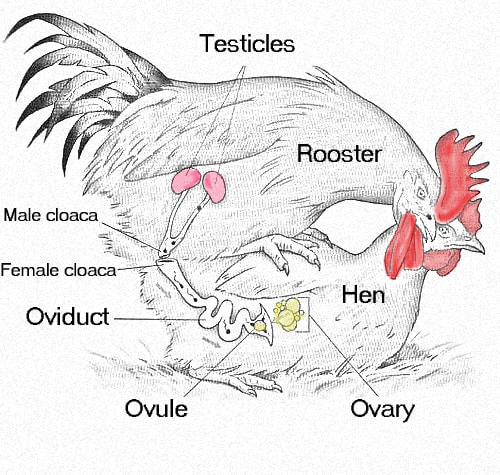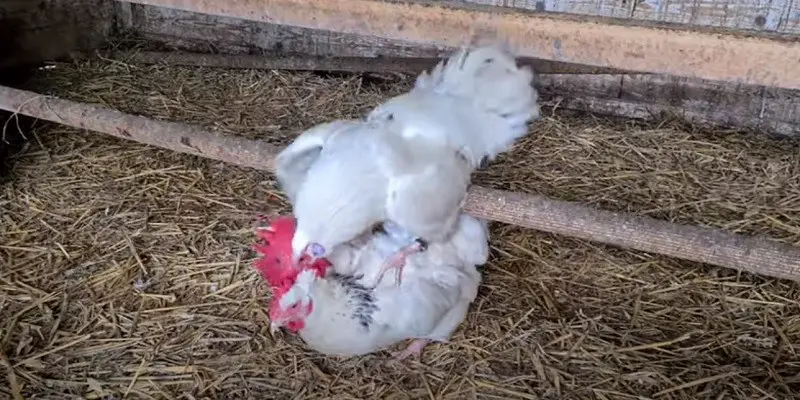Last Updated on April 23, 2025 by Pauline G. Carter
Chickens mate through a process called cloacal kiss, where the rooster transfers sperm to the hen. Chickens have a unique way of mating known as the cloacal kiss, where the rooster and hen come together in a brief reproductive act.
This process involves the transfer of sperm from the rooster’s cloaca, a common opening for both excretion and reproduction, to the hen’s cloaca. While this may sound unusual, it is actually a common method of mating for many bird species, including chickens.
We will explore the fascinating world of chicken mating, including the anatomy involved, the mating behavior, and the role of fertilization in the growth and development of new chicks. So, let’s dive in and discover the intricate process that allows chickens to reproduce and continue their lineage.

Credit: www.thehappychickencoop.com
The Biology Of Chicken Reproduction
Chicken reproduction involves a complex mating process. Roosters use a specific mating dance to attract hens, and copulation occurs through a cloacal kiss. Sperm is transferred to the hen’s oviduct where fertilization takes place, resulting in the development of fertile eggs.
Understanding the biology of chicken reproduction is essential for anyone who raises these fascinating birds. From the reproductive anatomy to the hormonal cycle, each aspect plays a crucial role in the mating process. In this article, we will explore the various factors that contribute to successful reproduction in chickens.
The Reproductive Anatomy Of Chickens
When it comes to chicken mating, it is important to familiarize oneself with the unique reproductive anatomy of these birds. Chickens possess two reproductive organs, known as ovaries. Each ovary consists of multiple small follicles that contain yolks. While roosters have testes, which produce sperm cells, they do not possess a penis like most mammals. Instead, chickens engage in a reproductive process known as cloacal contact, where the cloaca of the rooster and hen come into direct contact during mating.
The Hormonal Cycle Of Chickens
The hormonal cycle of chickens is vital for successful mating. Chickens go through a regular cycle involving the release of hormones that trigger the development of eggs and mating behaviors. This cycle can be divided into three phases: the pre-laying, laying, and post-laying phases. During the pre-laying phase, the hen’s reproductive tract prepares for ovulation, and she displays behaviors that attract the attention of roosters. As the laying phase commences, the hen releases an egg, which can then be fertilized during mating. Finally, the post-laying phase allows the hen’s reproductive system to rest before starting a new cycle.
Overall, the biology of chicken reproduction is an intricate process involving both the reproductive anatomy and hormonal cycle. Understanding these aspects is essential for those interested in breeding or raising chickens. By being familiar with the unique reproductive features of these birds, one can ensure a healthy and successful mating experience, leading to the growth of their flock.

Credit: www.adelaidechickensittingservice.com
The Mating Process
Chickens are fascinating creatures when it comes to the intricacies of their mating process. Understanding how chickens reproduce can provide valuable insights into their biology and behavior. In this article, we will delve into the courtship behavior and the act of mating in chickens.
Courtship Behavior
Before the act of mating takes place, chickens engage in a series of courtship behaviors. These courtship behaviors are essential for establishing a connection between the male and female chickens. So, what exactly happens during this courtship phase?
- Rooster Posturing: The rooster, also known as the male chicken, may engage in posturing to attract the attention of the hen. This posturing involves puffing up its chest, spreading its wings, and lifting its head high. The purpose of this display is to showcase its strength and dominance.
- Wing Drooping: Another courtship behavior observed in roosters is wing drooping. The rooster will droop its wings and make a slow, circular motion to grab the attention of the hen. This behavior is believed to be a way for the rooster to demonstrate its fitness and attractiveness.
- Dancing: Chickens are known for their unique mating dance. The rooster will often perform a dance by moving its feet and neck in a rhythmic manner. This dance serves as a way to captivate the hen and reinforce the rooster’s suitability as a mate.
The Act Of Mating
Once the courtship behaviors have successfully taken place, the stage is set for the actual act of mating between the rooster and hen to occur. Let’s explore what happens during this crucial moment.
- Mounting: The male chicken, or rooster, mounts the female chicken, or hen, by climbing on her back. With careful precision, the rooster aligns his cloaca, a specialized reproductive opening, with the hen’s cloaca.
- Cloacal Kiss: The cloaca-to-cloaca contact is colloquially known as the “cloacal kiss.” It is during this moment that the rooster transfers sperm to the hen. The sperm travels through the reproductive tract and fertilizes the eggs within the hen.
- Copulatory Tie: After successful copulation, a temporary joining of the rooster and hen may occur. This is known as a copulatory tie, where their cloacas remain connected for a short period. This ensures that the sperm is effectively transferred and increases the chances of successful fertilization.
The mating process in chickens usually occurs swiftly, but its significance is undeniable. Understanding these courtship behaviors and the act of mating sheds light on the fascinating world of chicken reproduction.
Reproduction In Chicken Farms
In chicken farms, reproduction is a vital process that ensures the continuity of the flock. Understanding how chickens mate and reproduce is important for breeders and farmers. In this section, we will explore two key aspects of chicken reproduction: artificial insemination and the role of roosters in breeding programs.
Artificial Insemination
Artificial insemination is a technique used in chicken farms to control and improve the breeding process. It involves the introduction of sperm into a hen’s reproductive tract without natural mating. This method allows breeders to carefully select the desired genetic traits and ensure successful reproduction.
Breeders collect semen from roosters, which contains the sperm cells necessary for fertilization. The semen is then carefully inserted into the hen’s oviduct using specialized equipment. The process requires expertise and precision to increase the chances of a successful fertilization.
Artificial insemination offers several advantages in chicken farms. It allows breeders to introduce new genetic traits into their flocks more rapidly, improving desired characteristics like egg production, growth rate, or disease resistance. Additionally, it enables breeders to preserve and propagate rare or endangered chicken breeds.
The Role Of Roosters In Breeding Programs
Roosters play a crucial role in chicken breeding programs. Their primary function is to provide sperm for fertilization. In a natural mating scenario, roosters engage in a courtship process known as “mating dance” to attract hens before copulation.
Roosters produce ejaculates that contain millions of sperm cells, which are essential for achieving fertilization. These sperm cells have unique genetic material that combines with the hen’s ovum during fertilization, leading to the development of a new chick.
Breeders select roosters based on specific criteria, such as desired genetic traits, health, and fertility. Careful selection ensures that the offspring inherit the desired characteristics, improving the overall quality of the flock.
Regular monitoring and evaluation of roosters’ reproductive performance are essential to maintain the breeding program’s effectiveness. This allows breeders to identify and eliminate roosters with reduced fertility, ensuring the best genetic potential is passed to future generations.
Reproductive processes like artificial insemination and the important role of roosters in chicken breeding programs is crucial for successful and efficient production in chicken farms. These methods and practices contribute to the development of healthy, high-quality flocks that meet the specific needs of breeders and consumers alike.

Credit: m.youtube.com
Frequently Asked Questions For How Do Chickens Mate?
How Do Chickens Actually Mate?
Chickens mate by the rooster mounting the hen and transferring sperm via his cloaca to the her cloaca, which contains the reproductive organs.
Why Do Hens Shake After Mating?
Hens shake after mating as a natural response to the rooster’s stimulation. It helps to distribute the sperm properly and increases the chances of successful fertilization. This shaking behavior is instinctive and ensures better reproductive success for the hens.
How Many Holes Do Chickens Have?
Chickens have two holes: one for laying eggs and the other for excreting waste.
How Does A Rooster Fertilize Eggs?
A rooster fertilizes eggs by transferring sperm to the hen’s reproductive tract during mating. The sperm then fertilizes the eggs as they are released from the hen’s ovary.
How Do Chickens Mate With Each Other?
Chickens mate by a mating dance performed by the rooster and a specific mating behavior.
Conclusion
To sum up, understanding how chickens mate allows us to appreciate the intricate process of reproduction in these fascinating creatures. From courtship rituals to the physical act itself, their mating behavior is driven by instinct. By catering to their natural needs and providing a conducive environment, we can ensure a successful mating process.
So next time you observe your chickens, you’ll have a deeper understanding of their reproduction cycle. Happy chicken keeping!

